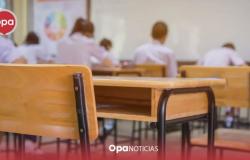The current water situation of Cordova capital and provincewhich accumulate 3,130 hectometers of water in its reservoirs, is “positive”», with a very different panorama than what existed just a year ago. This is how they explain it, on the occasion of the World Day to Combat Desertification and Droughtwhich is celebrated today, public companies Emproacsa and Emacsa, which manage the water of a large part of the municipalities of the province (the first) and the capital (the second). Without being too optimistic, the Manager of Emproacsa, Manuel Martínestimates that with these resources the province has the water supply guaranteed for at least two years, regardless of rainfall. For his part, the president of Emacsa, Jesus Cocadoes not dare to make a specific estimate, although he does assure that “there are water for a long period of time». Both the rains this spring and the reduction in consumption, which has fallen by 3% on average, according to the estimates of both companies, contribute to this more promising outlook.
Thanks to the awareness campaigns and efficiency measures applied By both entities, consumption has been achieved. Emacsa, for example, has a average domestic consumption of 120 liters per inhabitant per day and 130 liters for all uses. Consumption, according to sources from the municipal company, has decreased between 3 and 5%. Emproacsa, for its part, detected last year an average water consumption of 99 liters per day for domestic use and 140 liters per day for all uses.
The San Rafael de Navallana reservoir, after the spring rains.
Likewise, in the first quarter of 2024, the average consumption per inhabitant for domestic use fell to 80 liters per day (2.86% less than the same quarter of the previous year) and, taking into account all uses, to 112 liters, which meant 1.45% less than the previous year.
Jesús Coca details that within the thresholds that mark the Guadalquivir Hydrographic Confederation (CHG) “We are in a normal situation”, which, in his opinion, “is great news because we have not been in this situation for almost two years.” Regarding the estimation of resources, he adds that “they depend on many factors” such as “drought, heat or transpiration.” What he does assure is that “there is peace of mind” in this regard. What’s more, in April, the mayor of Córdoba, José María Bellido, predicted that the city would have a guaranteed water supply during six years.
On the other hand, Martín estimates that, taking into account the volume of the three reservoirs that supply water to the municipalities to which Emproacsa distributes water (IznajarMartín Gonzalo and Sierra Boyera), “we have water for two years if it didn’t rain at all and making prudent use” of it. The manager of the provincial company wanted to be very cautious, since he considers that “transmitting a message of abundance is dangerous.” He also adds that they influence «many factors», including Iznájar discharge for irrigation provision to agriculture. Both Those responsible urge not to let our guard downsince, they point out, the drought is not something “specific” or “temporary”, but rather “structural” in Córdoba.
For this, from Companies work to make their systems more efficient with different measures. Emacsa points out that one of them is the renewal of 97% of the supply network with which it achieves, according to technical sources, that the leakage rate is “very low”, around 10%. It also works on different wastewater regeneration projects for reuse. In fact, Coca has recalled that they are holding talks with the CHG to be able use three cubic hectometers of the 30 that the company regenerates for water city parks and gardens. Emproacsa, in addition to network improvements, appeals to monitoring the levels of the swamps to see how the situation evolves. As Martín explained, a few days ago they held a drought committee and within a month the next one will take place to determine the actions to be undertaken, depending on the situation. In the last drought committee it was approved to stop applying surcharges for excessive water consumption.
Reduce the amount of water used
He president of Emacsa and manager of Emproacsa They urge us not to let our guard down and to consume water responsibly. In this way, both entities advise changing lifestyle habits because “the drought is here to stay». Thus, they suggest not defrosting food under the tap; repair leaky faucets and do not leave these open while washing dishes, brushing teeth or eating food; and change the shower for the bathroom.
Take advantage and reuse water resources
In addition to trying to use the fair and necessary amount of water, they appeal to take advantage of what is possible. For example, While waiting for hot water to come out of the tap, you can fill a container with cold water, which can be used, for example, to scrub or water pots. For irrigation, they advise choosing the appropriate system. They also recommend covering the pools to prevent evaporation and promote their maintenance.
Apply savings measures within the home
Emacsa and Emproacsa advise apply savings measures at home. For example, if the cistern is ecological, press twice so that the flush is not complete. If it is not, place a bottle full of sand inside. Furthermore, if a faucet leaks, repair it as soon as possible, since you can lose more than 30 liters of water a day. Another recommendation is to close the stopcock if you are embarking on a trip of several days, in order to avoid possible leaks.






